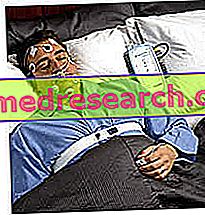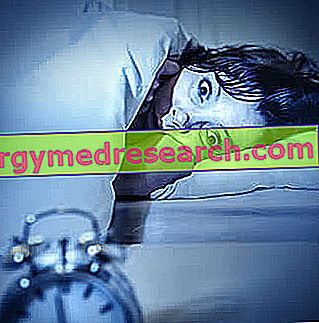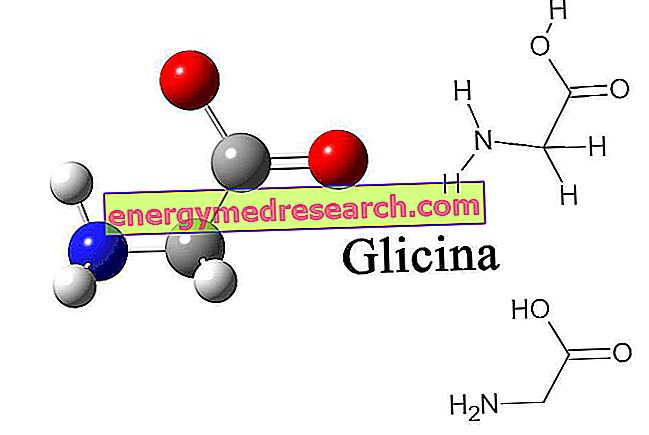Generality
Narcolepsy is a neurological disorder that causes repeated sleep attacks and a continuous feeling of daytime sleepiness. Sufferers fall asleep several times throughout the day, even when engaged in engaging activities.

Figure: the narcoleptic crises present themselves with an intense and invincible need to sleep; they occur preferably during moments of inactivity, especially after meals or in monotonous or repetitive situations, however, they can also arise during more or less stimulating activities, such as conversations, work, driving a car, moments of leisure or during a meal.
Image taken from: //blog.lib.umn.edu/
The diagnosis of narcolepsy is based, mainly, on the observation of how the patient's nocturnal sleep takes place; in this sense, specific tools and specific tests are available.
Unfortunately, narcolepsy is a chronic incurable disease. However, there are countermeasures and suitable drugs to alleviate the most severe symptoms.
Sleep and its phases
Before describing narcolepsy, it is appropriate to make a brief reference to the main characteristics of sleep . When one falls asleep, a transient loss of consciousness occurs, some biological functions are reduced and others are strengthened. For example, while the production of corticoid hormones is reduced, that of growth factors increases.
Sleep is characterized by two main phases, which follow one another several times (4-5 cycles):
- NON-REM phase, or orthodox sleep
- REM phase, or paradoxical sleep
Only the correct alternation between these two phases guarantees a restful rest.
THE NON-REM PHASE
It is characterized by 4 stages, during which sleep gradually becomes deeper. The first two stages are, respectively, sleep and light sleep. At the third stage, the deep sleep phase begins, reaching its climax in the fourth stage. It is in this last moment that the organism regenerates itself.
With each new cycle, the NON-REM phase lasts less and less, leaving more space for the REM phase.
THE REM PHASE
During this phase, the sleeping person makes sharp eye movements. The term REM, in fact, is the English acronym of Rapid Eye Movement, that is "rapid eye movement".
The REM phase is an "agitated" phase, in which the heart rate and respiratory rate increase and one dreams.
What is narcolepsy
Narcolepsy is a chronic condition that causes sudden attacks of sleepiness during the day. These feelings also arise in active and engaging moments of the day: it can therefore happen that the narcoleptic individual falls asleep while he is eating, working or talking.
Furthermore, the patient always feels tired and suffers from nocturnal sleep disorders, due to an incorrect alternation between the REM and the NON-REM phases. Sometimes, it loses control of its muscles (cataplexy and paralysis ) and suffers from hallucinations .
Narcolepsy is considered a neurological disorder, since, as we will see, a brain protein, called hypocretin or orexin, appears to be involved.
Epidemiology
Narcolepsy is not very common. Approximately 3-5 patients per 10, 000 people are affected and both men and women are affected in equal proportions.
Despite beginning to appear during adolescence (around 15 years), narcolepsy is not diagnosed until adulthood. In the early years, in fact, it is mistaken for listlessness or bad habits of the adolescent.
See also: Celebrities Affected by Narcolepsy
Causes
The exact cause of narcolepsy is unknown.
However, many narcoleptic patients have a common characteristic: the levels of hypocretin (also called orexin ), which is a small protein (peptide) in the brain, are reduced. This discovery intrigued researchers, who continued the research.
WHAT IS HYPOCRETIN AND HOW DOES IT WORK?
Hypocretin is a chemical neurotransmitter and appears to regulate sleep phases. When it is present in small quantities, the individual arrives at the REM phase of sleep without respecting the completion of the NON-REM phase.
But why do some individuals produce less hypocretin?
The researchers carried out several investigations. The most accredited hypothesis holds that at the origin of narcolepsy there is an autoimmune reaction, caused by a virus or a bacterium. In such reactions, the immune system, which protects us from pathogens, does not function properly. In fact, some antibodies, produced for the occasion, attack normal cells (in this case, those of the brain that produce hypocretin) and destroy them.
NB: studies on the role played by hypocretin (od orexina) are recent (2009) and need further study. Furthermore, the research must explain why some patients with narcolepsy have normal levels of orexin.
OTHER CAUSES
Hypocretin is not the only suspected cause of narcolepsy.
According to some surveys, there is a risk factor linked to heredity: in fact, 2 patients out of 100 have a close family member suffering from narcolepsy. This suggests that there may be one or more genes involved.
Furthermore, in 2009, a sudden increase in the disease was observed among children living in Finland. These adolescents had undergone a new vaccine against swine flu, the Pandemrix . Investigations, in this regard, are still continuing.
Symptoms
To learn more: Narcolepsy symptoms
The main symptoms of narcolepsy are as follows:
- Excessive daytime sleepiness and sudden sleep attacks
- cataplexy
- Hypnagogic hallucinations
- Sleep paralysis
- Automatic behavior
- Disturbed night sleep
The first four are the most characteristic and constitute, in fact, the so-called " tetrad of narcolepsy ". However, only excessive daytime sleepiness, associated with sleep attacks, is the ever-present symptom in narcolepsy patients.
All other disorders vary from subject to subject due to severity and appearance modalities: only a minority of narcoleptic patients (about 20%) show the entire symptomatology.
EXCESSIVE SLEEPNESS AND SUDDEN SLEEP ATTACKS
These are the symptoms that afflict the narcoleptic patient for life. They cause repeated daily naps, lasting from a few minutes to a few hours.
The classic bout of drowsiness, due to a boring situation or a period of physical stress, is normal and should not be confused with narcolepsy. The suspicion of narcolepsy must be born, instead, when the sleepiness and the sleep attacks go on for more than three consecutive months and arise even in active and unusual moments: for example, during a working activity or while you are eating or talking.
In narcoleptic patients, somnolence appears unexpectedly and, after the nap, the patient feels rested. However, the latter is a passing sensation and the patient falls back to sleep after a short time.
cataplexy
Cataplexy is the sudden loss of control of the body's muscles. Sufferers (about 7 out of 10 narcoleptic patients) feel a sudden lack of strength, while remaining conscious.
The ways in which cataplexy manifests are different; the table shows the main ones.
Typical expressions of cataplexy
- Head pendant
- Sagging of the knee
- Spoken talk
- Blurred view
- Drop an object
- Fall on the ground
Often, these expressions are preceded by strong emotions, such as anger, euphoria, surprise or fear. It is therefore believed that there may be a link between the patient's emotional state and cataplexy episodes. The duration of events is variable, from a few seconds to a few minutes, as well as the number of times during the whole day.
Sometimes, due to their similarity, cataplexy attacks are confused by epileptic phenomena. However, they are two different pathological circumstances.
HYPNAGOGICAL HALLUCINATIONS
Hallucinations are visions and perceptions of things and sounds that are not real. They are extremely intense dreams. In the narcolepsy patient, they occur, above all, in the passage from wakefulness to sleep (the so-called hypnagogic period ). However, although rarely, they can also occur shortly before awakening ( hypnopompic period ).
SLEEP PARALYSIS
Sleep paralysis usually occurs on awakening, but also shortly before falling asleep. The patient, from conscious, warns of not being able to move his body. In other words, it is not able to move the muscles, to speak or to open the eyes.
They are episodes lasting a few minutes, not dangerous for the patient's health and extremely useful at the time of the diagnostic investigation.
AUTOMATIC BEHAVIOR
By automatic behavior, we mean the circumstances in which the patient continues, inexorably, in his activity, despite feeling drowsy; drowsiness, which leads him to act without thinking: for example, driving to the wrong destination or, within a conversation, he says something inappropriate to the context.
The automatic behavior deserves considerable attention: the narcoleptic patient, who stands at the helm, endangers his own life and that of others, as he takes inappropriate actions and could fall asleep.
DISTURBED NIGHT SLEEP
Disturbed nocturnal sleep is a very common disorder and is manifested by insomnia . It appears to be caused by hypocretin deficiency and its effects on the phase shift between NON-REM and REM sleep.
The narcoleptic patient, therefore, while falling asleep during the day, sleeps the same number of hours as a normal individual.
Diagnosis
The diagnosis of narcolepsy is based, as a first step, on the medical history . By medical history, we mean the collection of information from the patient and family members, which can help the doctor in identifying the patient's disorder.
If after the medical history, the suspicion of narcolepsy is more than concrete, the patient is advised to consult a specialist. The latter will subject the patient to three tests, suitable for deciphering sleep disorders. They are:
- Polysomnography
- The multiple sleep latency test
- Epworth's scale of sleepiness
Finally, if doubts still remain, we rely on some clinical trials, such as the lumbar puncture . In this way, certain pathologies with symptoms similar to narcolepsy are excluded.
HISTORY
The doctor asks the patient to describe the quality of sleep at night, if he has ever suffered from paralysis or insomnia. In addition, he asks family members to find out if the patient has ever experienced episodes of cataplexy or automatic behavior, and to exclude obstructive sleep apnea . The latter causes daytime sleepiness, like narcolepsy.
It is then the physician's duty to inquire about any medications taken and the state of mind of the individual under examination. In fact, some active ingredients and depression can cause daytime sleep attacks.
The table briefly summarizes the history setting.
| history | |
This may be narcolepsy, if daytime sleepiness is accompanied by: | Narcolepsy may be excluded if daytime sleepiness is combined with: |
Insomnia | Obstructive sleep apnea |
Sleep paralysis | Certain drugs |
Cataplexy episodes | Depression |
Automatic behavior | |
EXAMS FOR SLEEP DISORDERS
They are three:
- Polysomnography . It consists of recording the brain, muscle and eye activities of an individual while he is sleeping.

- Multiple sleep latency test . This exam serves to assess how quickly the patient, who suffers from daytime sleepiness, falls asleep during the day. In other words, we measure the time from when the individual closes his eyes to when he enters the first stage of the NON-REM phase. In narcoleptics, this interval is very short. The test is applied the day after polysomnography and is reliable if 5 daily recordings are made.
- Epworth drowsiness scale . It is a test that asks several questions to the patient suffering from daytime sleepiness. The questions concern the likelihood of falling asleep in certain situations. If the totalized result is between 11 and 17, it is not narcolepsy; if it is 17 or more, it is narcolepsy.
CLINICAL TESTS
If, after performing the tests described above, doubts about the diagnosis remain, the patient can undergo two clinical checks:
- Lumbar puncture
- Brain magnetic resonance
Lumbar puncture
It consists of the removal of liquor (or cerebrospinal fluid ), by introducing a needle between the L3-L4 or L4-L5 vertebrae. The purpose of the examination is to measure the levels of hypocretin (or orexin), contained in the brain and in the cerebrospinal fluid.
It is a mildly invasive procedure. Therefore, it requires the due attention at the time of execution.
Therapy
Unfortunately, there is no specific therapy for narcolepsy.
However, treatments can be applied to stem sleep attacks. They are effective countermeasures, which improve the life of narcoleptic patients.
REGULAR NIGHT SLEEP
The patient is advised to have a good sleep routine . In other words, always lie down at the same time and try to sleep 8 hours a night.
Furthermore, it is also recommended to schedule a few daily naps, of no more than 15 minutes, to feel rested.
PHARMACOLOGICAL TREATMENT OF SONNOLENCE
The drugs used against drowsiness are the stimulants of the central nervous system. They have the function of reducing the number and severity of daytime sleep attacks.
The main stimulant is modafinil, but methylphenidate and amphetamines can also be administered. The results are good, but the possible side effects should not be overlooked.
PHARMACOLOGICAL TREATMENT OF CATAPLESSIA
Sodium oxybate (also known as sodium oxybate, or gamma-hydroxybutyrate ) is prescribed to the narcoleptic patient, who shows episodes of cataplexy. It is a drug with satisfactory effects, able also to decrease the frequency of hallucinations and sleep paralysis.
Always against cataplexy, antidepressant drugs guarantee good results.
Like drugs for sleepiness, sodium oxybate and antidepressants have side effects.
| Drugs for the treatment of narcolepsy | |
Against drowsiness: | Most common side effects: |
CNS stimulants:
| Headache, abdominal pain, stuffy nose, allergic reactions, nausea, constipation, vertigo. |
Against cataplexy, paralysis and hallucinations: | Most common side effects: |
Sodium oxybate | Nausea, vertigo, headache, blurred vision, abdominal pain. |
Antidepressants
| Constipation, blurred vision, headache, dizziness, nausea, lack of libido, dry mouth. |
To learn more: Narcolepsy Medications »
OTHER COUNTERMEASURES
The following recommendations are beneficial to the health of the narcoleptic patient because they promote night rest and reduce daytime sleepiness:
- Dedicate yourself regularly to physical exercise
- Avoid heavy meals and alcoholic beverages
Furthermore, it is very helpful for the patient to communicate his pathological condition without hesitation. This serves to facilitate their inclusion in the social context. In fact, a narcoleptic child, whose situation is unknown, encounters numerous difficulties: the teachers exchange his daytime sleepiness for laziness, while for his schoolmates he becomes an object of ridicule. The same applies to an adult, inserted in a working environment: the employer, if kept in the dark about the problem, can take strict measures. Vice versa, if informed, it can agree with the patient a series of pauses, which allow the latter to sleep for 10-15 minutes.
Prognosis
Narcolepsy is a chronic disease that lasts a lifetime. It is not lethal, but it is very dangerous for a patient when, for example, he is driving a vehicle or doing potentially dangerous work.
Diligently following the aforementioned therapeutic indications helps alleviate symptoms; conversely, a "disordered" life aggravates daytime sleepiness, making any kind of activity impossible.
Finally, it should be reiterated that narcolepsy drugs cause several side effects: therefore, they should not be abused.




